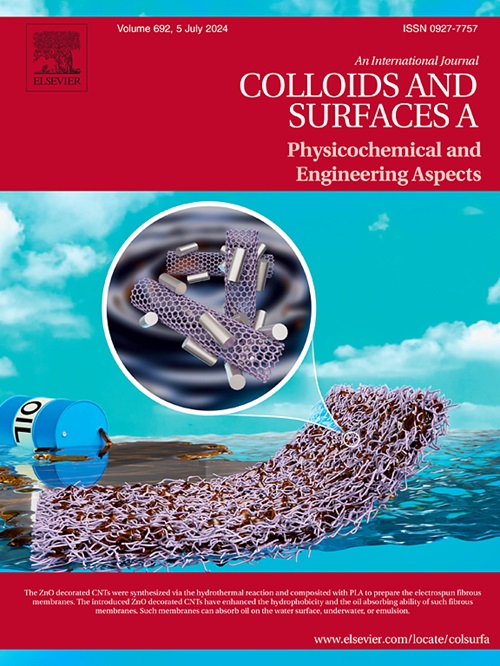Novel framework for PDMS membrane characterization: Droplet induced indentation and machine learning classification
IF 4.9
2区 化学
Q2 CHEMISTRY, PHYSICAL
Colloids and Surfaces A: Physicochemical and Engineering Aspects
Pub Date : 2025-06-24
DOI:10.1016/j.colsurfa.2025.137581
引用次数: 0
Abstract
We present a novel approach for determining the Young's Modulus of PDMS membranes by analyzing the bulge depth induced by a sessile droplet. The combined effects of Laplace pressure and droplet weight produce a measurable indentation. Statistical analysis revealed significant variations in bulge depth across PDMS compositions (10:1, 15:1, 20:1 elastomer-to-curing-agent ratio). To establish a correlation between Young’s Modulus and membrane deformation, droplet size, shape, and contact angles, we developed analytical models based on three strain assumptions: zero tangential strain, equal radial and tangential strain, and plane strain. While all models captured the trend of increasing stiffness with higher elastomer content, the zero tangential strain approach demonstrated the highest accuracy. This model estimated Young's Modulus for PDMS membranes as follows: (a) 10:1 ratio: , (b) 15:1 ratio: , and (c) 20:1 ratio: . These estimates align with reported values, confirming that for thin membranes (20–110 µm), the zero tangential strain model best describes deformation behavior. Additionally, machine learning algorithms—including Logistic Regression, SVM, Gradient Boosting, and Random Forest—achieved high classification accuracy ) in distinguishing membrane composition based on droplet shape, contact angle, and membrane deformation. This study presents a valuable framework for characterizing thin PDMS membrane mechanics, with significant implications for microfluidic device design.
PDMS膜表征的新框架:液滴诱导压痕和机器学习分类
我们提出了一种新的方法来确定PDMS膜的杨氏模量,通过分析由无底液滴引起的凸起深度。拉普拉斯压力和液滴重量的综合作用产生可测量的压痕。统计分析显示,不同组成的PDMS(弹性体与固化剂的比例分别为10:1、15:1和20:1)的凸起深度存在显著差异。为了建立杨氏模量与膜变形、液滴尺寸、形状和接触角之间的关系,我们基于三种应变假设建立了解析模型:零切向应变、等量径向和切向应变以及平面应变。虽然所有模型都捕获了随着弹性体含量的增加而增加刚度的趋势,但零切向应变方法显示出最高的精度。该模型估计PDMS膜的杨氏模量为:(a) 10:1比例:E=2.51±0.14MPa, (b) 15:1比例:E=1.14±0.24MPa, (c) 20:1比例:E=0.97±0.16MPa。这些估计与报告值一致,证实了对于薄膜(20-110µm),零切向应变模型最能描述变形行为。此外,机器学习算法——包括逻辑回归、支持向量机、梯度增强和随机森林——在基于液滴形状、接触角和膜变形来区分膜组成方面取得了很高的分类精度(≥0.96)。该研究为表征PDMS薄膜力学提供了一个有价值的框架,对微流控装置设计具有重要意义。
本文章由计算机程序翻译,如有差异,请以英文原文为准。
求助全文
约1分钟内获得全文
求助全文
来源期刊
CiteScore
8.70
自引率
9.60%
发文量
2421
审稿时长
56 days
期刊介绍:
Colloids and Surfaces A: Physicochemical and Engineering Aspects is an international journal devoted to the science underlying applications of colloids and interfacial phenomena.
The journal aims at publishing high quality research papers featuring new materials or new insights into the role of colloid and interface science in (for example) food, energy, minerals processing, pharmaceuticals or the environment.

 求助内容:
求助内容: 应助结果提醒方式:
应助结果提醒方式:


